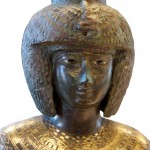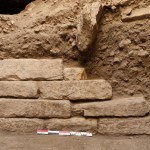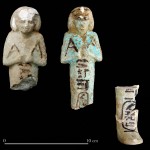Lost and found : the Tomb of the Divine Adoratrice Karomama (22nd Dynasty) brought to light at the Ramesseum
The French Archaeological Mission in Western Thebes (MAFTO/CNRS-UMR 8220/LAMS) and the Center for the Study and Documentation of Ancient Egypt (CEDAE/CSA) are proud to announce the identification of the tomb of Karomama during their 26th work season at the Ramesseum.
While staying in Luxor, around 1845, Karl Richard Lepsius was able to buy from a local antic dealer two canopic jars and nine shabtis bearing the name of the Divine Adoratrice Karomama from the 22nd Dynasty (around 850 B.C.). These objects were then told to come from a shaft uncovered at the Ramesseum (1).
Fifty years later, Quibell published another shabti of the same Divine Adoratrice, also found at the Ramesseum (2). Though its precise discovery area remains unclear, this last object was a welcome confirmation of the presence of the tomb of Karomama in the area of the Ramesseum.
The shaft has now finally been newly brought to light in the northern part of the small temple dedicated to queen Tuy, mother of Ramesses II. The systematic clearance of this shrine, led in collaboration with the Egyptological Institute of Leipzig University (http://www.gko.uni-leipzig.de/aegyptologisches-institut/startseite.html), is headed by Benoît Lurson and generously endowed by the Gerda Henkel Foundation (http://www.gerda-henkel-stiftung.de/).
The tomb is entered through a 5m deep vertical shaft leading to a subterranean chamber. At the bottom of the shaft were discovered the remnants of offerings and ceramics. The lower part of the blocking masonry is still in situ (figs. 1 and 2). Thirty fragments of shabtis bearing the name of the Divine Adoratrice Karomama are also part of the finds, lifting any ambiguity as to the owner of the tomb (fig. 2). At the end of this season only the entrance to the chamber, which appears to be paved, had been cleared.
Despite its quasi kingly status, Karomama remains veiled in mystery. Holding one of the most important cultual offices in Thebes, she is nevertheless known only through a very small amount of documents : fifteen shabtis, two canopic jars (http://commons.wikimedia.org/wiki/File:Canopic_Karomama_Lepsius.jpg), a small statue of goddess Maat found in Karnak, an usurped statue discovered by Lepsius already at the Ramesseum (Berlin ÄMP 2278) but above all by the magnificent bronze preserved at the Louvre (http://cartelfr.louvre.fr/cartelfr/visite?srv=car_not_frame&idNotice=17845&langue=fr) (3).
If this discovery is evidently important for the history of the Ramesseum and more specifically of the Third Intermediate Period necropolis that invaded some of its inner spaces, it could also lead to a better assessment of this period of late ancient Egypt.
([1]) LD III, pl. 256, b-c and f; LD III Text, pp. 136-137.
(2) J. E. Quibell, The Ramesseum (ERA II), 1896, pl. II, 11.
(3) See K. Jansen-Winkeln, Inschriften der Spätzeit. Teil II: Die 22.-24. Dynastie, 2007, pp. 226-228.
Lors de son passage à Louxor, Karl Richard Lepsius avait fait l’acquisition chez un antiquaire de deux vases canopes et de neuf oushebtis au nom de la divine adoratrice Karomama (XXIIe dynastie), dont on lui avait dit qu’ils avaient été trouvés dans un puits, au Ramesseum (1). Un demi-siècle plus tard, dans sa publication des fouilles du Ramesseum, Quibell reproduit un oushebti au nom de la même divine adoratrice (2). Il ne précise pas l’endroit où il l’a trouvé, mais cet objet est néanmoins suffisant pour confirmer que la tombe de Karomama devait bien se trouver quelque part dans le temple.
La Mission Archéologique Française de Thèbes-Ouest (MAFTO/CNRS-UMR 8220/LAMS) et le Centre d’Étude et de Documentation sur l’Ancienne Égypte (CEDAE/CSA) sont désormais en mesure d’annoncer que la tombe de Karomama a été identifiée durant la campagne de fouilles 2014 (XXVIe campagne). Elle se situe dans le sanctuaire nord du Temple de Touy. La fouille de ce temple, qui se déroule en coopération avec l’Institut d’Égyptologie de l’Université de Leipzig (http://www.gko.uni-leipzig.de/aegyptologisches-institut/startseite.html), est dirigée par Benoît Lurson. Elle bénéficie d’un financement de la Fondation Gerda Henkel (http://www.gerda-henkel-stiftung.de/).
La tombe comprend un puits d’environ 5 mètres de profondeur, au fond duquel s’ouvre la chambre. Les vestiges encore in situ d’un important dépôt d’offrandes et de céramiques ont été retrouvés dans le puits. La partie inférieure du blocage de l’entrée de la chambre funéraire, en pierres appareillées, était toujours en place (fig. 1 et 2). Une trentaine d’oushebtis fragmentaires au nom de la divine adoratrice ont été trouvés à l’entrée de la chambre, qui permettent d’attribuer la tombe à Karomama (fig. 3). Au terme de la campagne, seule l’entrée de la chambre a été dégagée.
Malgré le statut quasi royal de Karomama, la divine adoratrice reste mal connue. Les seuls documents à son nom se limitaient jusqu’ici à une quinzaine d’oushebtis, les deux vases canopes, une statuette de Maât provenant de Karnak, une statue usurpée trouvée par Lepsius au Ramesseum (Berlin ÄMP 2278) et, surtout, la très belle statue en bronze damasquiné conservée au Musée du Louvre (http://cartelfr.louvre.fr/cartelfr/visite?srv=car_not_frame&idNotice=17845&langue=fr) (3). Aussi la découverte n’est-elle pas seulement d’un grand intérêt pour l’histoire du Ramesseum et, en particulier, de la nécropole de la Troisième Période Intermédiaire qui s’y est installée. Elle pourrait aussi permettre de mieux connaître cette période de l’histoire de l’ancienne Égypte.
([1]) LD III, pl. 256, b-c et f; LD III Text, pp. 136-137.
(2) J. E. Quibell, The Ramesseum (ERA II), 1896, pl. II, 11.
(3) Voir K. Jansen-Winkeln, Inschriften der Spätzeit. Teil II: Die 22.-24. Dynastie, 2007, pp. 226-228.



